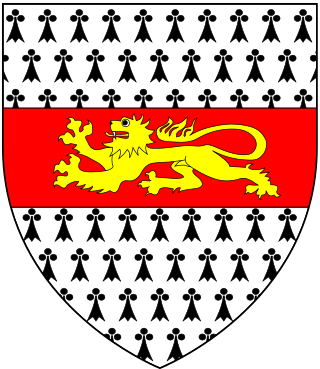
The title Duke of Abercorn is a title in the Peerage of Ireland. It was created in 1868 and bestowed upon James Hamilton, 2nd Marquess of Abercorn. Although the Dukedom is in the Peerage of Ireland, it refers to Abercorn, West Lothian, and the Duke also bears four titles in the Peerage of Scotland and two in the Peerage of Great Britain, and is one of three peers who have titles in those three peerages. The Duke of Abercorn also claims the French title of Duke of Châtellerault, created in 1548.
Lord Belhaven and Stenton, of the County of Haddington, is a Lordship of Parliament in the Peerage of Scotland. It was created in 1647 for Sir John Hamilton, 2nd Baronet, with remainder to his heirs male.

Earl of Gainsborough is a title that has been created twice, once in the Peerage of England and once in the Peerage of the United Kingdom. The first creation ended in extinction when the sixth Earl died without heirs. However, the title was revived in 1841 for a female-line relative.

Viscount De L'Isle, of Penshurst in the County of Kent, is a title in the Peerage of the United Kingdom. It was created in 1956 for William Sidney, 6th Baron de L'Isle and Dudley (1909–1991).

Earl of Carysfort was a title in the Peerage of Ireland. It was created in 1789 for John Proby, 2nd Baron Carysfort. The Proby family descended from Sir Peter Proby, Lord Mayor of London in 1622. His great-great-grandson John Proby represented Huntingdonshire and Stamford in the House of Commons. His son and namesake John Proby was a Whig politician and notably served as a (civilian) Lord of the Admiralty. In 1752 he was raised to the Peerage of Ireland as Baron Carysfort, of Carysfort in the County of Wicklow. He was succeeded by his son, the second Baron. He was also a politician and was created Earl of Carysfort in the Peerage of Ireland in 1789. In 1801 he was further honoured when he was made Baron Carysfort, of the Hundred of Norman Cross in the County of Huntingdon, in the Peerage of the United Kingdom, which gave him a seat in the British House of Lords. His eldest son and heir apparent, William Proby, Lord Proby, predeceased him.

Earl of Marlborough is a title that has been created twice, both times in the Peerage of England. The first time was in 1626 in favour of James Ley, 1st Baron Ley, and the second was in 1689 for John Churchill, 1st Baron Churchill, the future Duke of Marlborough.

There have been three baronetcies created for persons with the surname Booth, one in the Baronetage of England and two in the Baronetage of the United Kingdom. The 1916 creation remains extant, the 1835 creation became extinct in 1896 and the 1611 baronetcy has been dormant since 1797. The senior line of the first creation was elevated to the peerage as Baron Delamer and Earl of Warrington.

Lord Claud Hamilton PC was a British Conservative politician. He notably served as Treasurer of the Household in 1852 and between 1858 and 1859 and as Vice-Chamberlain of the Household between 1866 and 1868.
There have been ten baronetcies created for persons with the surname Browne, six in the Baronetage of Great Britain, three in the Baronetage of Ireland and one in the Baronetage of Nova Scotia. Only one creation is extant as of 2010. Three of the creations were for members of the Browne family headed by the Viscount Montagu.
Charles Hamilton, 5th Earl of Abercorn succeeded his brother who had been attainted as a Jacobite and, having conformed to the established religion, could get the attainder reversed.
There have been two baronetcies created for people with the surname Heathcote, both in the Baronetage of Great Britain and both created in 1733. The holders of the first creation were later elevated to the peerage as Baron Aveland and Earl of Ancaster, which titles are now extinct. However, both baronetcies are extant as of 2008.
Douglas James Proby DL, JP, known as Douglas James Hamilton until 1904, was a British politician and soldier.
There have been three baronetcies created for persons with the surname Bernard, one in the Baronetage of England, one in the Baronetage of Great Britain and one in the Baronetage of the United Kingdom. Two of the creations are extinct and one is extant.
There have been two baronetcies created for persons with the surname Howard, both in the Baronetage of the United Kingdom. One creation is extinct while the other is extant.

There have been four baronetcies created for persons with the surname Hope, three in the Baronetage of Nova Scotia and one in the Baronetage of the United Kingdom. As of 2010 one creation is extant, one dormant and two extinct.

John Proby of Elton Hall, Huntingdonshire was an English lawyer and independent politician who sat in the English and British House of Commons at various times between 1693 and 1710.
There have been four baronetcies created for persons with the surname Hay, all in the Baronetage of Nova Scotia. Two creations are extinct, one dormant and one extant. A fifth baronetcy in the Jacobite Peerage, although theoretically extant, is not recognised by the Lyon Office.
There have been four baronetcies created for persons with the surname Seton, all in the Baronetage of Nova Scotia. As of 2008 one creation is extant, one dormant and two extinct.

Earl of Arran is a title in the Peerage of Ireland. It is not to be confused with the title Earl of Arran in the Peerage of Scotland. The two titles refer to different places: the Aran Islands in Ireland, and the Isle of Arran in Scotland. The Irish earldom is held by the Gore family. The Scottish earldom is a separate title, held as a subsidiary title of the Duke of Hamilton.









